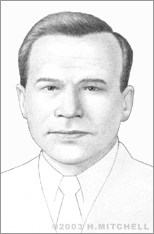Peter Goldmark
Peter Carl Goldmark was born in Budapest, Hungary in 1906. He studied physics at the University of Vienna, where he received his BS in 1929 and his PhD in 1931, and began his career working for a radio company in England. In 1933, he emigrated to the United States and worked as a construction engineer until 1936, when he joined CBS, or Columbia Broadcasting System, as Chief Engineer of the Television Department.
At CBS, Goldmark created what is known as the first commercial color television system. His used a rotating three-color (red, green, and blue) disk. He conducted experiments with the system from the top of the Chrysler building in New York in 1940. It would be 14 years before the first color television sets were marketed to the public, but he made it known that the potential was real. His system was approved by the Federal Communications Commission, but soon after, an all-electronic color system was developed that was compatible with black-and-white sets. Thus, his system was never commercially used.
In 1948, Goldmark and his team developed a product that revolutionized the music industry – the 33 1/3 RPM disc and LP (long-playing) phonograph. This system increased the playing time of records, and the microgroove discs, which were made of vinyl rather than shellac and clay, were much improved in terms of surface noise and much less breakable. These 12-inch discs also weighed far less than the traditional 78 RPM disc, saving the record producer, shipper, and retailer a great deal of money in handling and storage costs. But most importantly, they allowed the listener to settle in for a long play period and didn’t require them to flip the disc often like the 78 RPMs did. Goldmark also developed the “Highway Hi-Fi,” which allowed drivers to play records in their cars. These first appeared in Chrysler automobiles in 1956.
Goldmark served in subsequent positions at CBS, including director of research and development, vice president of CBS Labs, and president and director of research. He was constantly innovating, developing groundbreaking devices such as a scanning system used by the Lunar Orbiter spacecraft in 1966 to transmit photographs from the moon to the earth, and contributing to video cassette recording technology that led to the advent of the VCR. He is credited with more than 160 inventions in communications-related fields.
Goldmark died on Dec. 7, 1977.


